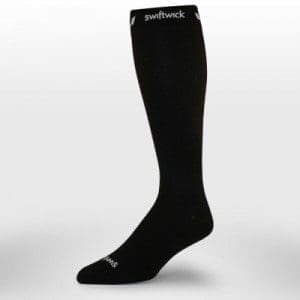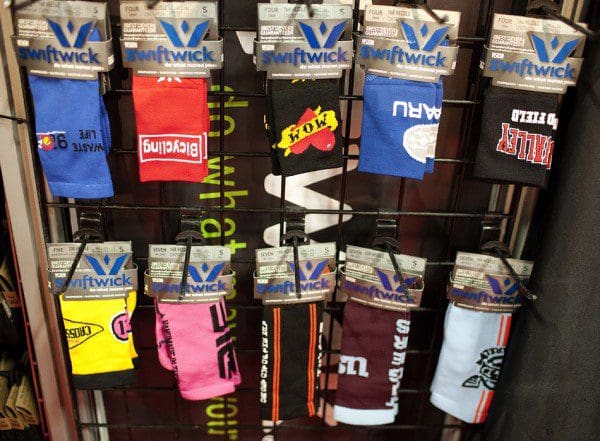Last year I had the chance to try out and review Swiftwick’s Aspire line of compression socks. I loved the socks and was excited to get the chance to review another pair of Swiftwick socks after this year’s InterBike. After the show, Swiftwick sent a sample of their brand new Medical Recovery+ socks for testing which I have been wearing for a few weeks now.
Medical Recovery+ Compression Sock
 The Medical line is Swiftwick’s newest sock on the market. It is the first athletic recovery sock in the industry to achieve a medical class II rating. The socks have several applications; travel comfort, sport recovery, swelling, and Deep Vein Thrombosis can all be addressed with the Recovery+.
The Medical line is Swiftwick’s newest sock on the market. It is the first athletic recovery sock in the industry to achieve a medical class II rating. The socks have several applications; travel comfort, sport recovery, swelling, and Deep Vein Thrombosis can all be addressed with the Recovery+.
Deep Vein Thrombosis
While somewhat counter-intuitive, it is important to point out that cyclists, as endurance athletes, can be at an increased risk of developing DVT. The condition occurs when a blood clot forms in the extremities (often in the legs). This is a very dangerous situation that, if not recognized and treated, could potentially lead to death.
Endurance athletes have a unique risk of developing DVT. There are risk factors that you might not even consider, after all we are fitter than most of the rest of the population so how could we possibly be at risk for something that is usually associated with sedentary lifestyles?[clear]
Let me take you through a typical scenario for a competitive endurance athlete:
The athlete is fit, with a low resting heart rate. In fact, when in peak shape, this athlete’s resting heart rate is in the 40s. The cyclist arrives at his race after a 3 hour drive and prepares for the event. He finishes his race but during his cool-down he takes a spill. It is a mild fall with no injuries other than to his ego. He packs up his car and heads out on his 3 hour journey back home. Even though he is a bit dehydrated from the day’s effort, he is in a rush to get back home to his family so he pushes through without stopping to grab a drink. On Monday he returns to work, sitting at his desk most of the day. [pullquote cite=”Elizabeth Quinn” type=”right”]A growing number of studies suggest that the use of compression socks may, in fact, speed recovery and reduce soreness after a strenuous workout. The results vary, but the trend points to a decrease in reported muscle soreness and possibly less muscle damage and faster recovery when using compression socks post-exercise.[/pullquote]
In this scenario there are plenty of risk factors present that could increase the athlete’s risk of DVT. Sitting for long periods of time, dehydration, trauma from a fall, and even the low heart rate (slower blood flow) all put him at greater risk of developing DVT.
So how are compression socks supposed to help prevent this potentially serious condition? The Recovery+ socks are made with graduated compression. Simply stated, the greatest amount of compression is built into the sock at the arch of the foot. The sock’s compression gradually decreases up the leg. This aids in returning the blood from the leg to the heart. Swelling and discomfort can also be relieved with the use of the compression socks.
Recovery
Recovery after a hard race or ride is very important for athletes. It is in the recovery phase that we actually get stronger. Therefore, anything that assists or speeds up your recovery is very beneficial for performance and training.
When used for recovery purposes, compression socks increase circulation throughout the leg. Increased blood flow means increased oxidization of the tissue resulting in better and speedier recovery. The reduction in swelling and soreness are additional benefits for athletes recovering from hard workouts.
So is there any evidence to back up compression for recover? While the jury is still out on sports performance compression, the research is showing a real benefit from compression on recovery. Exercise Physiologist Elizabeth Quinn points out some of the benefits seen in athletes using compression wear, “A growing number of studies suggest that the use of compression socks may, in fact, speed recovery and reduce soreness after a strenuous workout. The results vary, but the trend points to a decrease in reported muscle soreness and possibly less muscle damage and faster recovery when using compression socks post-exercise.”
Review
Like other Swiftwick socks I have worn, these are very comfortable. They have the same foot-bed as their other socks and the 375 needle-count produces a tight weave which is smooth, soft, and durable. Like a high thread-count bed sheet, they feel great on your feet. The compression can be felt throughout the sock but is not restrictive and they are a bit easier to get on and off than the Aspire compression line (which are made for performance so their compression is slightly different). In addition, the socks are antimicrobial which helps keep the socks smelling fresh.
While purely anecdotal, I have found that my recovery does seem to be a little better between workouts if I have worn the Medical Recovery+ socks between workouts. I have worn them during the day, overnight, and immediately after workouts.
I can say that between the research, my previous experiences with Swiftwick products, and my own experience with these compression socks, I would not hesitate to recommend these to athletes looking to improve their comfort, recovery, and prevent possible complications from DVT.
The Recovery+, which retails for 69.00, was created specifically with athletes in mind. They also have the Health+ sock which is designed for people who are not as active and are meant to be worn for shorter periods of time. the Health+ retails for 24.99.
We have a big giveaway coming up this holiday season and our readers will have their chance to win a pair of these socks of their very own. Check back for details but if you want to win, you should follow us on Facebook and Twitter for your chance to win one of the great prizes.
Featured Photo by David Tsai














